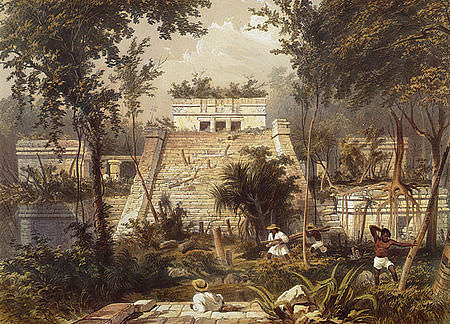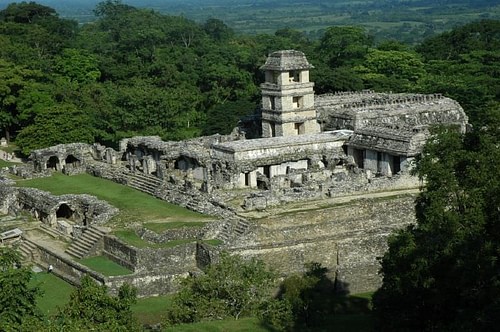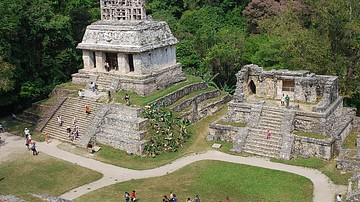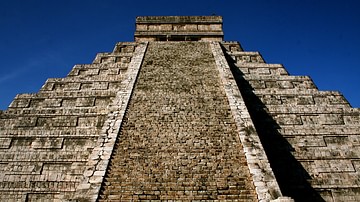The names of John Lloyd Stephens and Frederick Catherwood are forever linked to the Maya and Mayan studies as the two great explorers who documented the ruins from Copan in the south to Chichen Itza in the north. The stories told by Stephens in his Incidents of Travel in Central America, Chiapas and Yucatan (1841) and Incidents of Travel in Yucatan (1843) complemented by Catherwood's illustrations, focused international attention on the Maya civilization. Catherwood's publication of his book of lithographs Views of Ancient Monuments in Central America, Chiapas and Yucatan (1844) furthered the worldwide interest and lifted the Maya civilization out of obscurity and into world consciousness.
As noted elsewhere, Stephens and Catherwood were not the first explorers of the ancient Mayan sites (though they are routinely designated so). They were, however, the first to visit so many sites and, more importantly, to document what they found there with precision and accuracy.
John Lloyd Stephens was born on 28 November 1805 in Shrewsbury, New Jersey, graduated Columbia with a law degree, and practiced law in New York until he was diagnosed with a throat infection. Following the advice of his doctor, Stephens left New York for a change in climate and traveled extensively through Europe, the Mediterranean, Asia Minor, Palestine, and Egypt. These travels would result in the publication of his first two books, Incidents of Travel in Egypt, Arabia Petraea and the Holy Land (1837) and Incidents of Travel in Greece, Turkey, Russia and Poland (1838) both of which were immensely popular and earned Stephens the nickname 'the American Traveler'.
Frederick Catherwood was born on 27 February 1799 in north London and, by his twenties, was already well known as an architect, artist, and traveler. He had already published his drawings of structures in Egypt, Palestine, Asia Minor, and Greece and, in 1833, was the first Westerner to survey and draw the Dome of the Rock in Jerusalem. The two men met in London in 1836 where Catherwood's panorama 'The Ruins of Jerusalem' was on display. Both men were interested in exploring the region so vividly depicted in the published accounts of Mesoamerica by earlier explorers like Antonio del Rio and Juan Galindo and the drawings of Mayan sites by Jean-Frederic Maximilien, Comte de Waldek (Drew, 54-56). They agreed to travel together to the region at the first opportunity.
Stephens was famous enough as a world traveler and writer to have President Van Buren appoint him Ambassador to Central America from the United States, and he and Catherwood left New York for British Honduras (modern-day Belize) on 3 October 1839 (Drew, 37). Though conscious of his diplomatic duties, Stephens was primarily interested in exploring the ancient ruin of Copan and then moving on to Palenque. At this time, many of the now-famous Maya sites were unknown even to the indigenous people of the region. The centuries had slowly covered the great temples and pyramids and turned them into mounds of green hills. Only a few cities of the Maya were known to exist at this time, among them Copan, Palenque, Topoxte/Tayasal (called `Islapag' by Galindo), and the mysterious unnamed city deep in the jungle (which came to be known as Tikal). There were no accurate maps of the region and the two men often discovered sites through word of mouth in conversation (one example of this being Catherwood's discovery of Quirigua). They traveled without any of the extensive entourage which usually accompanied 19th-century explorations. They had only a guide, some men to carry equipment, and a crudely drawn map which they had already been told was inaccurate. Even so, this did not stop them from exploring the jungles of Mesoamerica in search of the ancient sites, which they had heard of and read about. In his Incidents of Travel in Central America, Chiapas and Yucatan, Stephens writes of his first impressions of Copan:
Diverging from the base, and working our way through the thick woods, we came upon a square stone column, about 14 feet high and three feet on each side, sculptured in very bold relief, and all four sides, from the base to the top. The front was the figure of a man curiously and richly dressed, and the face, evidently a portrait, solemn, stern, and well fitted to excite terror. The back was of a different design, unlike anything we had ever seen before, and the sides were covered with hieroglyphics. This our guide called an 'Idol' and before it, at a distance of three feet, was a large block of stone, also sculptured with figures and emblematical devices, which he called an altar.
The sight of this unexpected monument put at rest at once and forever, in our minds, all uncertainty in regard to the character of American antiquities, and gave us the assurance that the objects we were in search of were interesting, not only as the remains of an unknown people, but as works of art, proving, like newly discovered historical records, that the people who once occupied the Continent of America were not savages.
Stephens paid fifty dollars for the city of Copan and, as he says, was thought a fool by the owner for buying such useless land. He hoped to move the city en masse to a museum in New York but found no means of doing so. He became convinced, after only a short time in the region, that the theories regarding Hebrew or Egyptian or Atlantean origins for the Maya ruins and glyphs were wrong and that the structures and language were both autochthonous. Having mapped and recorded the site of Copan, they moved on through the jungle, mapping, and recording sites such as nearby Quirigua and Zaculeu on their way to Palenque.
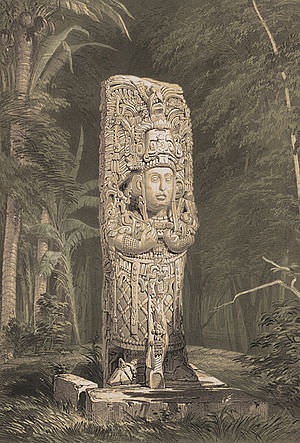
Stephens and Catherwood explored each site together and then set themselves to their respective tasks of writing and drawing the area. Catherwood used a device called the camera lucida which would project the image from the lens onto paper so that the artist could draw it more accurately. It is because of the use of this device that Catherwood's depictions of the Mayan sites are so precise right down to the intricate scrollwork and inscriptions on the buildings (Danien, Sharer, 15). Although some have criticized his work as `overly romantic', his lithographs have been used by Mayanists in the modern day in helping to restore the buildings and temples depicted in his work. Catherwood does sometimes seem to take license in placing items, objects, or figures in a composition for artistic purposes, but the depictions of the buildings themselves are regarded as completely accurate. At Palenque, Catherwood contracted malaria but continued to work in spite of his illness. Stephens describes him as refusing to rest and continuing to draw wearing gloves and netting to keep the mosquitoes away. Stephens' narrative is very descriptive in detailing the problems encountered with ticks, mosquitoes, stinging flies, bats, and mice not to mention having to hack through thick jungle and clearing the sites enough to see what lay beneath the overgrowth.
In New York, Stephens had met a man named Simon Peon who owned a large tract of land in the northern Yucatan called Hacienda Uxmal and had provided Stephens with a rough map to find the ruins he said were there. Leaving Palenque, and stopping at any site they came across or heard about, they made their way up to Uxmal. Among the sites they discovered or documented on this trip were Copan, Kabah, Merida, Palenque, Quirigua, Q'umarkaj (Utatlan), Sayil, Tonina, Topoxte, and Uxmal. Although they did not visit Tikal, Stephens mentions the white towers of the city and notes their approximate location. They remained at Uxmal, documenting that site extensively, until 31 July 1840. By this time, Stephens had also contracted Malaria and they left the Yucatan for the United States. The book which was published from these travels fascinated the world and prompted another trip to the Yucatan (this time along with Dr. Samuel Cabot) in 1841-1842 which resulted in the publication of Incidents of Travel in the Yucatan and, later, Catherwood's book of lithographs, Views of Ancient Monuments in Central America, Chiapas and Yucatan. On this second trip, they documented sites such as Ake, Chichen Itza, Dzibilnocac, Itzamal, Labna, Mayapan, Tulum, and re-visited Uxmal. They mapped, surveyed, drew, and wrote about 44 distinct Maya sites all of which have become national treasures and, some, world-famous attractions.
After the second trip, both men decided to retire from travel. John Lloyd Stephens directed his energies to running the Ocean Steam Navigation Company and, after that, the Panama Railroad Company. He personally went to Panama to oversee the laying of the track and clearing of the land. Either in Panama or Bogota he is said to have suffered an accident and this, along with the toll taken by his travels, is thought to have caused his death on 13 October 1852 at his home in New York at the age of 46. Frederick Catherwood went west after their adventures and opened up a supply store in San Francisco, California to capitalize on the miners flocking there after the Gold Rush of 1849. His reputation endured as an artist, however, and his works were displayed in Manhattan salons and galleries. Returning from a trip to London aboard the S.S. Arctic in 1854, Catherwood was among the over 350 passengers who died when the ship entered a thick fog bank and was rammed by the steamship Vesta on 27 September. He was 55 years old.
The work they did lay the foundation for all future study of the Maya civilization. They meticulously documented the sites they visited, carefully charted the courses they took, and logged the time in travel between one site and the next. In reading Stephen's narrative, and following the maps drawn by Catherwood, other explorers were able to expand upon their work to bring the Maya Civilization to light. In 1857 Desire de Charnay arrived in the region and used their work to help chart his own exploration to more Mayan sites. Teobert Mahler also made use of their books in his photographic journey of the sites in 1876. In 1891 Sir Alfred Percival Maudslay came to the region and dramatically changed the scope and depth of all further excavations. Maudslay is understood as the first explorer to employ a strict scientific method in excavating and examining the sites of the ancient Maya. He helped to preserve and protect many notable sites and set the standard for future expeditions and excavations. Following Maudslay, many very notable explorers made further great advances in clearing, documenting, and photographing the Maya sites. William Holmes began work at Palenque in 1895, the same year Teobert Maler documented Tikal, and was followed by Alfred Tozzer. In 1914, Sylvanus Griswold Morley first came to the region, best known for leading the team which excavated Chichen Itza in 1923. In 1925 Franz Bloom so extensively documented Palenque that his work, like Morley's, remains important reference material for Mayanists in the field today. In less than one hundred years since Stephens and Catherwood began their first journey, the Maya Civilization had become recognized as one of the greatest produced by the ancient world.
